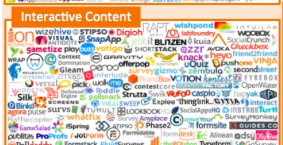This summer we gave our intern, Paige DiPerte, the herculean task of helping us make sense of the constantly expanding universe of MarTech. In this post, Paige gives us a glimpse into the world of interactive content, and identifies some providers to check out. 
It’s no secret that engaging content creates more value for users and extends their loyalty as customers, and the vanilla content of whitepapers, eBooks, or infographics is not cutting it.
Even though Buzzfeed quizzes tend to be kitschy, these methods of engagement consistently are listed as “Trending” on the site. From finding out which Harry Potter character died last to learning instructions for how to operate a device, users are choosing engaging content like assessments, calculators, polls, brackets, and interactive videos. It’s not a surprise that DemandGen shared in 2016 report that 84% of B2B buyers prefer interactive content, while 83% want content to be more interactive.
This rise of active and personal learning puts users in a place to engage with content and then make informed, substantive decisions. This powerful form of absorption is beginning to shape marketing consumption into a constructivist framework.
At the same time, behind-the-scenes, marketers are donning the white coats of realists. Careful observation and analysis of the data gleaned from interactive content is a marketer’s gold mine.
Traditionally, marketing can infer a user’s “digital body language” from a footprint of website history, clicks, downloads, and emails opened to generate lead scores and segment labels. Problems, however, arise both in communicating intent through the data and in the traffic between marketing automation platforms (MAPs) and CRM tools.
The emergence of marketing apps has created a new divergence in lightweight, usable tools to deliver “microservices” for interactive content. And no, this isn’t an app like Instagram. Marketing apps are web-based and don’t require installation, can work on any device, and can be published or taken down at any time without the constraints of AppStore.
Not only do these marketing apps implicitly engage users, breed more enthusiasm, and feed users more memorable information, but they also supply brands with the very data that allows them to know their customers on a more personal level. If you score wrong on a quiz, it tells marketing what you don’t know. If you calculate your ROI, you are providing sales with the metrics of your business.
The stars of interactive content understand that it’s not all about the data, though. Vendors like Ion Interactive and Ceros allow marketers to create tools without any programming background. This eliminates cookie-cutter polls and quizzes, allowing them to customize their tools directly for their customers that they know and understand best.
Right now this means that active learning is intertwining with the data-based realism to deliver leads in more interactive ways. So what’s your excuse for not using them?
Paige DiPrete is a rising junior at Georgetown University studying Global Business and Portuguese. As an account service intern at gyro in Washington, D.C., she manages agency-client communication and researches MarTech insights.

